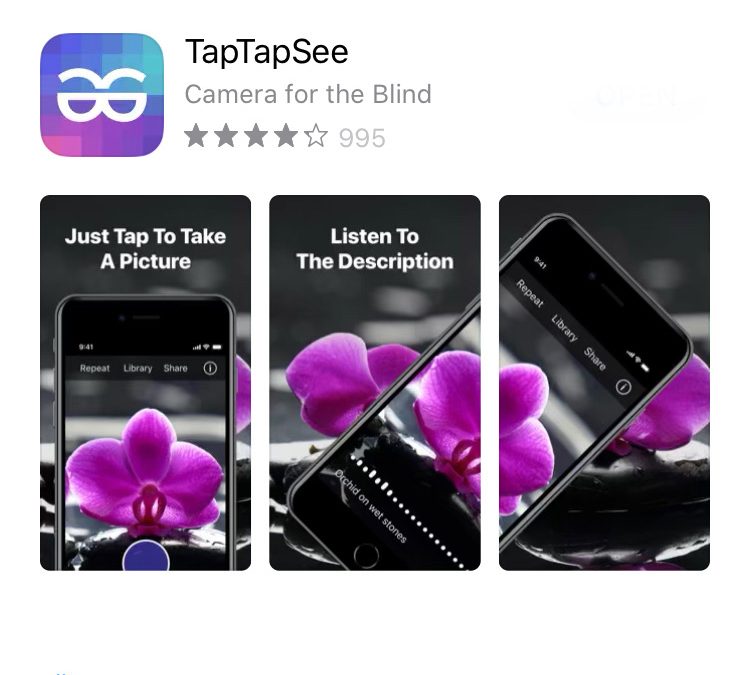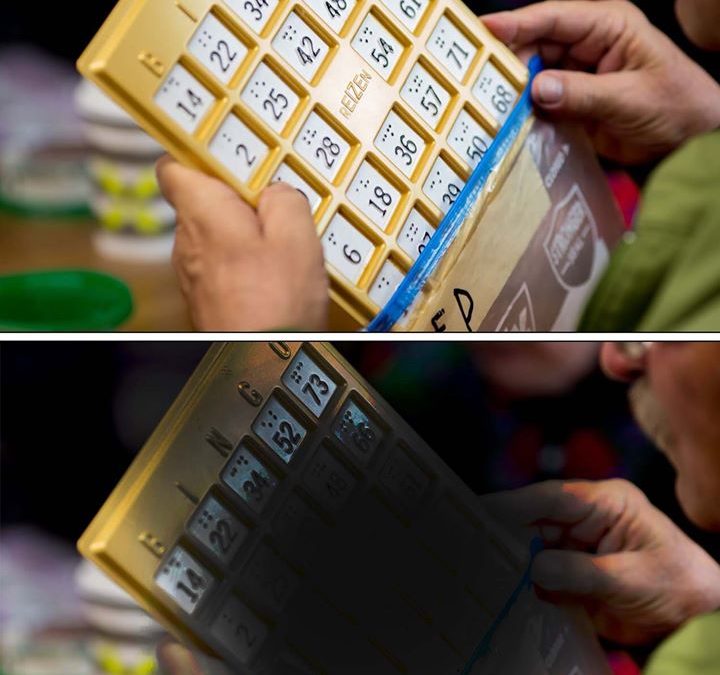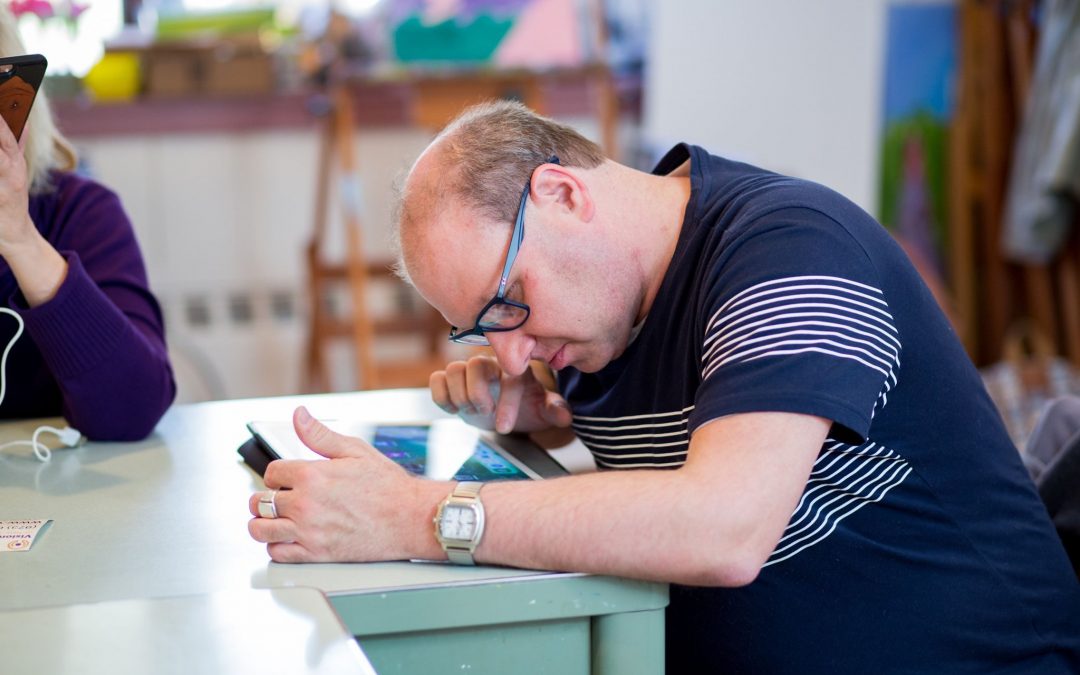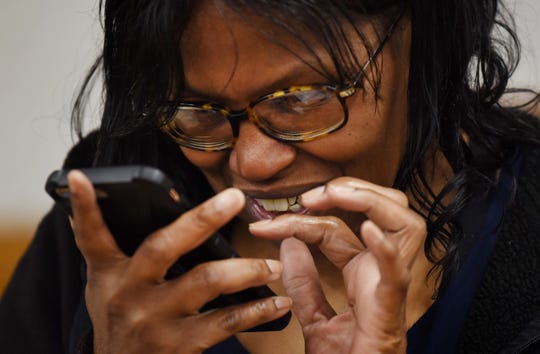
by admin | Feb 9, 2020 | Blog, News
TapTapSee is an application designed specifically for users who are blind or have low vision, utilizing your device’s camera and VoiceOver functions to take a picture or vide of anything and identify it out loud for you! 📸
TapTapSee is one of the apps our students learn to use in the Apps Club, that meets on Thursdays as part of our Better Health & Wellness Program. Want to find out more? Reach out via email: LGroszew@vlanj.org, or via phone: 973-627-0055 ext. 1312.
Image description: A screen shot of the TapTapSee application as it appears in the Apple App Store. The top left indicates the thumbnail of the app, which is a white outline of glasses and eyebrows on a multicolor background featuring blue, pink and teal hues. The Text reads “TapTapSee camera for the Blind”, a 4 out of 5 star rating, indicating 995 reviews. The bottom shows three different phone screens, with the text, “Just Tap To Take A Picture” in the first image, with a picture of a phone taking a photo of a fuchsia colored flower, and the text “Listen To The Description” in the second image. All 3 images show different angles of the phone and flower.

by admin | Feb 7, 2020 | Blog, News
Not all Vision is 2020 – have you ever heard of age-related macular degeneration (AMD)?
It’s the leading cause of severe, permanent vision loss in people over age 60. AMD happens when the small central portion of your retina, called the macula, wears down. Because the disease happens as you get older, it’s often called age-related macular degeneration. It usually doesn’t cause blindness but might cause severe vision problems.
There are two types of AMD – wet & dry.
What are the symptoms of AMD?
- Worse or less clear vision. Your vision might be blurry, and it may be hard to read fine print or drive.
- Dark, blurry areas in the center of your vision.
- Rarely, worse or different color perception.
If you have any of these symptoms, go to an eye doctor as soon as possible. What to do if you are witnessing severe vision loss from AMD or any other eye disease? Reach out to us! At Vision Loss Alliance of New Jersey, we offer a variety of programs for people who have low vision or are blind, in order to help them gain new skills and independence for navigating a life without eye sight.
Ways to get in touch:
📧 lgroszew@vlanj.org
☎️ 973-627-0500 ext 1312

by admin | Feb 4, 2020 | Blog, News
There are different levels of vision loss and different levels of blindness – being considered legally blind does not necessarily mean the person can’t see anything.
Using nonvisual techniques and tools like a cane when some vision remains doesn’t mean the person is “faking” it. They’re just picking techniques that are most efficient and safe to use with the vision they have left!
Be kind and be courteous, and if you’d like to find out more about the type of vision loss the person has – ask them if they’d be interested in teaching you about it!
At Vision Loss Alliance of New Jersey, we are dedicated to helping people who are blind or have low vision by offering programs that help them learn new skills and gain confidence for an independent life. Want to find out more about our programs? Reach out to the Program Director, Linda Groszew at lgroszew@vlanj.org or at 973-627-0055 ext. 1312.
by admin | Feb 2, 2020 | Uncategorized
Exciting tech news from across the ocean: a clinical study of GiveVision Virtual and Augmented Reality Device, conducted in the United Kingdom, has shown great promise to restoring eye sight for people who have irreversible vision loss.
All participants who received the device had low eye vision, which cannot be corrected by neither prescription glasses nor surgery. They had to evaluate the improvement of three main elements of eyesight. Those are binocular distance visual acuity, reading acuity, as well as contrast sensitivity.
The responses of the participants indicated that 98% of them (59 out of 60) experienced an improvement in visual acuity, some almost to the extent of regaining 20/20 vision!
Find out more about the study by clicking the link below:
Recent Study Proves GiveVision VR Device Helps the Visually Impaired Recover Eyesight

by admin | Feb 1, 2020 | Blog, News
On Tuesdays, we offer a program that centers around accessible technology. 📲
Students learn about various features of the iPhone and iPad that are designed to make the user experience easier for people who are blind or have low vision. They also learn basic functions of the devices, such as email, texting, and using the internet, and are taught about apps for daily living & organization.
Can you make a small donation to help us continue to offer programs like Technology Tuesday? Any contribution helps! You can donate by clicking the link below:
vlanj.org/donations.
Thank you!




